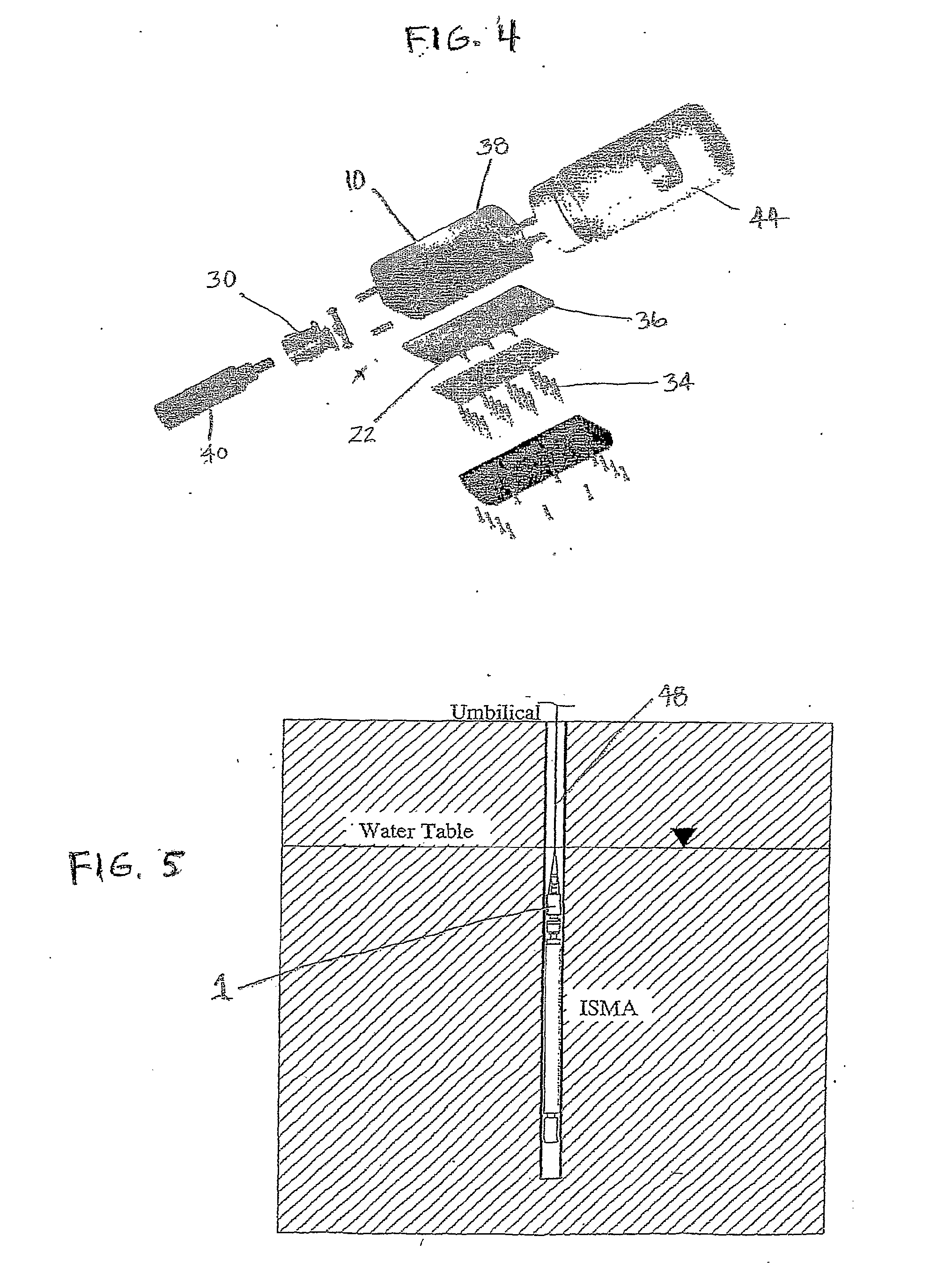Methods and systems for sampling, screening, and diagnosis
a sampling and screening technology, applied in the field of methods and systems for sampling, screening and diagnosis, can solve the problems of difficult and time-consuming isolation and identification of unknown microorganisms, difficult to predict which microorganisms will be most useful at a given site, and cannot always be easily applied to real-world situations, etc., to achieve the effect of being reusable or disposable, and being simple to mak
- Summary
- Abstract
- Description
- Claims
- Application Information
AI Technical Summary
Benefits of technology
Problems solved by technology
Method used
Image
Examples
example 1
[0116] One embodiment of the present invention takes the form of an in situ microcosm array (ISMA) sampler or testing device 1. This embodiment of the device is well-suited for analysis of environments such as sub-surface water sources or aquifers. As shown in FIGS. 1-4, its principal components include: a housing or container 10 having a fluid inlet 12 and outlet 14, a plurality of capillary microcosms 16 situated within this housing, with these capillaries 16 making up what is referred to as a microcosm array, each of these capillaries 16 having an inlet 18 and outlet 20 that are configured so as to allow for fluid flow through the capillaries 16, each of these capillaries contains an optional filtration material 22 that is selected for its ability to foster microorganism collection in the individual capillaries, upper 24 and lower 26 valve plates having openings 28 that are configured to be alignable with the capillary inlets 18 and outlets 20, a pneumatic cylinder 30 with coupli...
example 2
[0121] In this Example, cells of a bacterium (S. wittichii strain RW1) were identified using MALDI TOF mass spectrometry and multidimensional mass spectrometry in conjunction with peptide mass fingerprinting and peptide sequencing.
[0122] Culturing of Strain RW1. Liquid cultures of S. wittichii strain RW1 (DSMZ 6014) were grown at 30° C. in a water bath shaker in M9 phosphate-buffered minimal medium supplemented with (i) dibenzofuran (DF) crystals (Sigma-Aldrich; Milwaukee, Wis.), (ii) 50 mM glucose, or (iii) both. Saturated DF medium contained approximately 3-5 mg 1−1 of the binuclear aromatic compound in the dissolved phase. Turbidity of the cultures was monitored using a DR / 4000U spectrophotometer (Hach, Loveland, Colo.) at a wavelength of 560 nm. Viable bacteria were enumerated by plate counts using M9 medium supplemented with 1.5% agar (Difco, Franklin Lakes, N.J.) and 5 mM sodium benzoate. Negative control samples composed of cells of RW1 lacking the dioxin dioxygenase were ob...
example 3
[0146] In this Example, a parasite is detected by use of MALDI TOF MS.
[0147] Schistosomes are parasites in a wide variety of warm-blooded hosts. In mammals and humans, they cause serious diseases. It is estimated that hundreds of millions of people worldwide are infected with schistosomes. Infection occurs when cercaria, a free-swimming larval form of the parasite found in contaminated water, penetrate the skin of the mammalian host.
[0148] Detection of the cercariae in water is conventionally performed by skimming the cercariae from the surface of the water, followed by visual observation by a parasitologist. As an alternative, use of MALDI TOF MS was investigated. A schematic representation of the detection method is shown in FIG. 7 (some optional steps are also shown in FIG. 7).
[0149] Methods. Lyophilized cercariae of Schistosoma mansoni were divided into fractions of approximately 2,500 cercariae and resuspended in 50 mM ammonium bicarbonate. Cells were disrupted using a Fishe...
PUM
 Login to View More
Login to View More Abstract
Description
Claims
Application Information
 Login to View More
Login to View More - R&D
- Intellectual Property
- Life Sciences
- Materials
- Tech Scout
- Unparalleled Data Quality
- Higher Quality Content
- 60% Fewer Hallucinations
Browse by: Latest US Patents, China's latest patents, Technical Efficacy Thesaurus, Application Domain, Technology Topic, Popular Technical Reports.
© 2025 PatSnap. All rights reserved.Legal|Privacy policy|Modern Slavery Act Transparency Statement|Sitemap|About US| Contact US: help@patsnap.com



